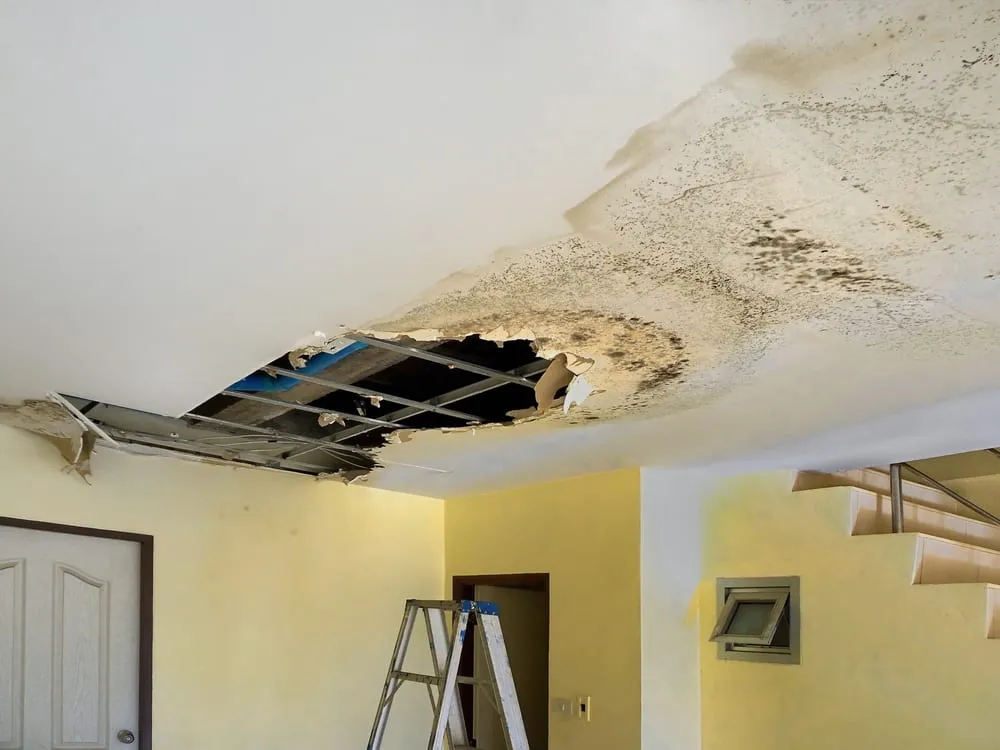A water leak from the ceiling can be a homeowner’s nightmare. Not only does it signal a potential issue with your roof or plumbing, but it can also lead to costly damage to your property. In this article, we will investigate the various causes of water leaking from the ceiling, helping you understand the source of the problem and how to address it effectively.

Understanding the Gravity of Ceiling Water Leaks
Water leaks from the ceiling are more than just an inconvenience. They can cause significant damage to your home, including:
- Structural Damage: Prolonged exposure to water can weaken the structural integrity of your home. It can lead to rot, mold, and even compromise the safety of your property.
- Cosmetic Damage: Stains, peeling paint, and unsightly watermarks on your ceiling are not only aesthetically displeasing but also diminish your property’s value.
- Health Concerns: Excessive moisture can promote mold growth, which can lead to health issues for you and your family.
- Electrical Hazards: Water leaks can pose electrical risks if they come into contact with wiring or fixtures.
Common Causes of Water Leaks from the Ceiling
- Roof Issues:a. Missing or Damaged Shingles: If your roof’s shingles are missing or damaged, water can seep into the underlying layers and find its way into your home.b. Flashing Problems: Flashing is the metal material that seals roof joints and other vulnerable areas. Damaged or improperly installed flashing can lead to leaks.c. Ice Dams: In colder climates, ice dams can form on the roof, causing water to back up and infiltrate the interior.d. Aging Roofs: Over time, even well-maintained roofs can deteriorate, making them susceptible to leaks.
- Plumbing Issues:a. Leaking Pipes: A common cause of ceiling leaks, leaking pipes can be due to wear and tear, corrosion, or even frozen pipes in the winter.b. Blocked Drains: Clogged or blocked drains can cause water to overflow, affecting not only plumbing fixtures but also potentially damaging your ceiling.c. Burst Water Heaters: A burst water heater can release a significant amount of water into your home, causing ceiling damage.
- HVAC System Problems:a. Condensation: If your HVAC system is not functioning correctly, condensation can build up, leading to ceiling leaks.
- Attic Issues:a. Poor Ventilation: Inadequate attic ventilation can lead to moisture buildup, which can eventually result in water leaks.b. Inadequate Insulation: Poor insulation can cause temperature fluctuations in the attic, leading to condensation and water issues.
Dealing with Ceiling Water Leaks
- Identify the Source: The first step is to identify the source of the leak. This may require a professional inspection, especially for roof-related issues.
- Temporary Measures: In the event of a ceiling leak, use buckets or containers to catch the dripping water. You can also poke a small hole in the ceiling to allow the water to drain into a container rather than spreading across a larger area.
- Turn Off the Water: If the leak is caused by a plumbing issue, turn off the water supply to the affected area or your entire home if necessary.
- Call a Professional: For many of these issues, it’s crucial to consult with a professional roofer, plumber, or HVAC technician to address the problem effectively.
- Preventive Measures: Consider taking preventive measures to avoid future leaks. This may include regular roof maintenance, plumbing inspections, and ensuring proper attic ventilation.
Read too: Are Floor To Ceiling Windows Expensive
Conclusion
Water leaking from the ceiling is a situation that demands immediate attention. By understanding the potential causes of such leaks, you can take swift action to mitigate damage and prevent future incidents. Whether it’s a roofing issue, plumbing problem, or HVAC malfunction, addressing the root cause is essential for safeguarding the integrity of your home and the well-being of your family. If you encounter a ceiling leak, don’t delay in seeking professional assistance to resolve the issue promptly and effectively.